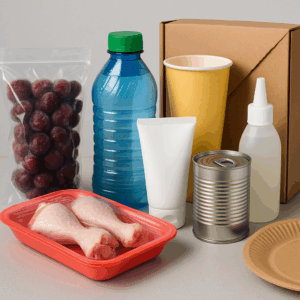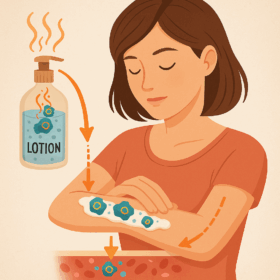
Why am I, someone who runs a personal‑care product company, talking about food packaging? Because it’s all related. What you put on your body can absorb into your bloodstream just like the food you eat. Several comprehensive reviews document that dermal contact can lead to systemic absorption of environmental chemicals ¹ ⁻ ². When you combine that exposure with everything else—processed food, candles, cosmetics, and household cleaners—you’re looking at a synergistic load of chemicals your body has to deal with daily.

That’s why this recent Nature Medicine article caught my attention. It presents a landmark study of >10,000 samples of food packaging, containers, and household items, revealing widespread leaching of potentially toxic chemicals—including phthalates, bisphenols, and per‑ and polyfluoroalkyl substances (PFAS)—all linked to hormone disruption, metabolic disorders, and even cancer ³ (see Results, p. 12‑14).
But They’ve Always Been Around, Right?
Plastic packaging and chemical‑laden containers are so normalized we don’t think twice. Frozen cherries come in plastic bags. Salad greens in plastic tubs. Your shampoo and lotion—plastic bottles again. They’ve been there since we were kids, and they’re still here now. We assume they’re safe because surely, if they weren’t, someone would’ve done something by now. Right? This is where the problem lies. Toxicology calls the phenomenon where harm isn’t immediately visible a **latency period**—damage that can take years or decades to manifest, especially when exposures are low but constant ⁴ (Discussion, p. 8). That’s how endocrine disruptors work: low doses over time create chronic, often irreversible harm.
Examples We Don’t Think About
Plastic bags for frozen foods, paper coffee cups with plastic lining, food‑delivery containers, plastic wrap around raw meats—all have been shown to leach chemicals. Laboratory tests have demonstrated that PET (#1) containers can release estrogenic compounds under elevated temperatures ⁵ (Table 2). BPA from polycarbonate (#7) is widely documented. Phthalates and PFAS can migrate from packaging into food and personal‑care items. A 2012 study showed PET‑bottled water contained hormone‑disrupting compounds, with concentrations rising the longer the water was stored ⁶ (Results, p. 3‑4).
What Can You Do?
- Avoid plastic when you can. Choose glass, stainless steel, or cardboard‑based containers whenever possible.
- If you must use plastic, never leave it in a hot car or microwave it. Heat dramatically increases migration of phthalates, BPA, and PFAS ⁷ (Methods, p. 9).
- Check the container label. Many plastics are marked with a recycling number. Generally, avoid #3 (PVC), #6 (Polystyrene), and #7 (Other). Safer options include #2 (HDPE), #4 (LDPE), and #5 (PP).
- Be conscious before you buy. Ask yourself—if this product is healthy, why is it packaged in something potentially harmful? Is there a safer version?
Be Vocal
Let companies know you care. Don’t just compliment a great formula—ask about the bottle, the lid, the wrap. Tell them if you passed on buying a product because of the packaging. Consumer voices make a difference.
Regulatory Movement
While the FDA has restricted BPA in baby bottles and sippy cups, broader regulations have lagged behind. Prior attempts to ban BPA in all food containers failed under industry pressure. PFAS restrictions are gaining traction, but loopholes remain. As of 2024, several U.S. states have enacted their own packaging‑safety laws, yet there’s still no universal federal standard ⁴ (Policy Overview, p. 15).
At Nature’s Complement
We understand that the journey to health includes every detail—from the ingredients in your lotion to the bottle it comes in. As a company that values health over convenience, we do the homework on all our containers and choose the safest packaging for each application. That’s why some of our final products don’t come in the common toxic containers you see on store shelves. Since we do the research for you, you can rest assured that when you buy from us, we’ve selected the least toxic ingredients and packaging we can find.
Final Thought
The article in Nature Medicine was so thorough and eye‑opening, I had to share it with my readers. It shines a light on a growing health concern that’s often overlooked. If you’d like to dive into the research yourself, you can view the full article here:
https://www.nature.com/articles/s41591-025-03697-5.
References
- Bronaugh RL, Maibach HI (eds.). Percutaneous Absorption: Drugs—Cosmetics—Mechanisms—Methodology (4th ed.). Boca Raton, FL: CRC Press; 2005. (Chapters 3‑4 discuss systemic uptake of environmental chemicals through skin.)
- Sax L. Polyethylene terephthalate may yield endocrine disruptors. Environ Health Perspect. 2010;118(4):445–448. PMID: 20368129. (Demonstrates estrogenic activity of PET under heat.)
- Muncke J, Touvier M, Trasande L, Scheringer M. Health impacts of exposure to synthetic chemicals in food. Nature Medicine. 2025;31(5):1431–1443. doi:10.1038/s41591-025-03697-5. (Large‑scale sampling of >10 000 packaging items; reports leaching of phthalates, bisphenols, PFAS.)
- Yang CZ, Yaniger SI, Jordan VC, Klein DJ, Bittner GD. Most plastic products release estrogenic chemicals: A potential health problem that can be solved. Environ Health Perspect. 2011;119(7):989–996. PMID: 21367689. (Introduces the concept of latency periods for low‑dose endocrine disruptors.)
- Bach C, Dauchy X, Chagnon M‑C, Etienne S. Chemical compounds and toxicological assessments of drinking water stored in polyethylene terephthalate (PET) bottles: A source of controversy reviewed. Water Res. 2012;46(3):571–583. PMID: 22196043. (Shows estrogenic compounds leaching from PET under heat.)
- Wagner M, Oehlmann J. Endocrine disruptors in bottled mineral water: Total estrogenic burden and migration from plastic bottles. Environ Sci Pollut Res Int. 2009;16(3):278–286. PMID: 19274472. (Documents hormone‑disrupting chemicals in bottled water, increasing with storage time.)
- Muncke J. Exposure to endocrine disrupting compounds via the food chain: Is packaging a relevant source? Sci Total Environ. 2009;407(16):4549–4559. PMID: 19482336. (Highlights temperature‑dependent migration of phthalates, BPA, PFAS from packaging.)
Nature's Complement is a participant in the Amazon Services LLC Associates Program, an affiliate advertising program. If you purchase products on Amazon through any of our affiliate links, we get a small percentage of the transaction, at no extra cost to you. We spend a lot of time writing the articles on this site, and all this information is provided free of charge. When you use our affiliate links, you support the writing you enjoy without necessarily buying our products. (However we would appreciate if you would do that too!) Thank you for helping to support our work, however you choose to do so.
These statements have not been evaluated by the Food and Drug Administration. This information and/or products are not intended to diagnose, treat, cure or prevent any disease.


